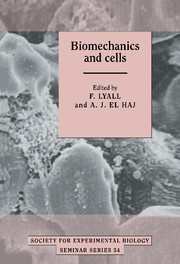Book contents
- Frontmatter
- Contents
- List of contributors
- PART 1 SOFT TISSUE
- PART 2 HARD TISSUE
- Cellular modelling of mechanical interactions with the skeleton
- Mechanical and hormonal influences in vivo cause regional differences in bone remodelling
- Mechanically sensitive cells in bone
- Mechanical stress and bone development
- Application of homogenous, defined strains to cell cultures
- Role of arachidonate in load transduction in bone cells
- Effects of mechanical stretch on actin polymerisation in fibroblasts of the periodontium
- Modulation of cartilage extracellular matrix turnover by pulsed electromagnetic fields (PEMF)
- Index
Mechanically sensitive cells in bone
Published online by Cambridge University Press: 19 January 2010
- Frontmatter
- Contents
- List of contributors
- PART 1 SOFT TISSUE
- PART 2 HARD TISSUE
- Cellular modelling of mechanical interactions with the skeleton
- Mechanical and hormonal influences in vivo cause regional differences in bone remodelling
- Mechanically sensitive cells in bone
- Mechanical stress and bone development
- Application of homogenous, defined strains to cell cultures
- Role of arachidonate in load transduction in bone cells
- Effects of mechanical stretch on actin polymerisation in fibroblasts of the periodontium
- Modulation of cartilage extracellular matrix turnover by pulsed electromagnetic fields (PEMF)
- Index
Summary
Functionally adaptive control of bone architecture
Adaptation of bone architecture in relation to functional loading is a characteristic feature of bone physiology. In mammals and birds at least it is the mechanism on which the establishment and maintenance of load-bearing competence depends.
In connective tissues, unlike muscle, loads are sustained by an extracellular matrix. In tendon, ligament and cartilage resident cells throughout the structure may produce, remove and adapt matrix in their immediate vicinity, so regulating the amount of tissue present and altering its mechanical properties. In contrast, since bone matrix is rigid any change in bone architecture has to be accomplished by deposition of new tissue, and/or removal of old, either on existing surfaces or within voids excavated within the existing structure. The process of bone formation is performed by local mesenchymally derived osteoblasts whereas resorption requires haematogenously derived osteoclasts. Osteoclasts are, however, substantially influenced in their activity by osteoblasts (Chambers, 1985).
In bone, as in the other load-bearing connective tissues, one of the prime responsibilities of the resident cells is to maintain sufficient tissue present, with appropriate material properties, to sustain, without damage, the loads applied to it. Tissues subject to tension (such as tendon and ligament) self-align with load and so their shape is not critical. In contrast bones must withstand tension, compression, bending and torsion while providing the constant shape necessary for the close tolerances of joint surfaces and the consistent location of muscle attachments.
- Type
- Chapter
- Information
- Biomechanics and Cells , pp. 178 - 186Publisher: Cambridge University PressPrint publication year: 1994
- 1
- Cited by



